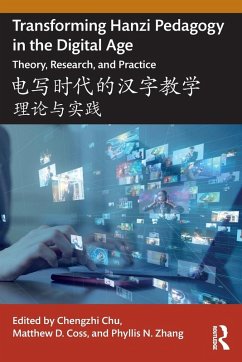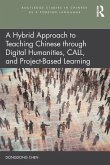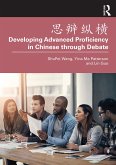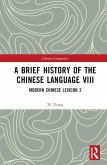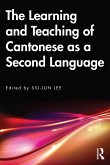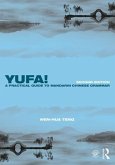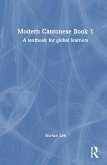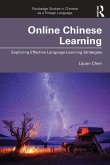Transforming Hanzi Pedagogy in the Digital Age brings together expert researchers and practitioners to offer a coherent theoretical, empirical, pedagogical, and experiential justification for a shift in pedagogical focus from handwriting to e-writing in L2 Chinese pedagogy.
This volume argues for a pedagogy based on the 21st century communicative needs of L2 Chinese users, grounded in empirical research as well as practical and lived experiences. The authors propose an "e-writing as primary" ( ) framework for L2 Chinese instruction in the 21st century, a transformational proposal which will fundamentally shift the pedagogical focus of L2 Chinese instruction globally towards more learner-centered, research-informed practice. This volume includes three theoretical foundation chapters, four empirical studies, three descriptions of program-level implementation, and ten expert L2 Chinese user vignettes, which, taken together, offer a thorough introduction to e-writing for the future of L2 Chinese teaching and learning.
This book will be informative for Chinese language instructors, researchers, program directors, materials developers, and advanced graduate students in both CFL and CSL contexts worldwide.
This volume argues for a pedagogy based on the 21st century communicative needs of L2 Chinese users, grounded in empirical research as well as practical and lived experiences. The authors propose an "e-writing as primary" ( ) framework for L2 Chinese instruction in the 21st century, a transformational proposal which will fundamentally shift the pedagogical focus of L2 Chinese instruction globally towards more learner-centered, research-informed practice. This volume includes three theoretical foundation chapters, four empirical studies, three descriptions of program-level implementation, and ten expert L2 Chinese user vignettes, which, taken together, offer a thorough introduction to e-writing for the future of L2 Chinese teaching and learning.
This book will be informative for Chinese language instructors, researchers, program directors, materials developers, and advanced graduate students in both CFL and CSL contexts worldwide.
"Just as digital communication has become indispensable in our daily lives, so too has technology-based communication become a central skill area for learners of Chinese as an additional language. This volume, which skillfully presents theoretical rationales, empirical research, and practical experience on e-writing-based L2 Chinese pedagogy, is a long-awaited and highly innovative contribution to our field."
Xiliang Cui ( ), Professor of Chinese Linguistics, Beijing Language and Culture University; Past President of Beijing Language and Culture University
"I have paid close attention to the emergence and evolution of digital writing in L2 Chinese teaching and learning over the last decade. This innovative volume demarcates the arrival of a new era of e-writing for L2 Chinese pedagogy. Further, it has brought together a dedicated group of scholars and pedagogues to offer expert insight into the future of L2 Chinese teaching and learning."
Chang-Mo Hsu ( ), Professor Emeritus of Chinese, National Cheng Kung University; Past President, Association of Teaching Chinese as a Second Language of Taiwan
"This volume presents an exceptional level of originality, fundamentally reshaping the research terrain of Hanzi and Chinese language instruction for the digital age. Undoubtedly, it constitutes a pivotal achievement for the e-writing movement, laying a solid and field-specific theoretical foundation for the global Teaching Chinese to Speakers of Other Languages community."
Quan Li ( ), Professor of International Chinese Education, Renmin University
"The book provides a long-awaited yet revolutionary approach to the learning and teaching of Chinese characters both in terms of theory and practice, and is a must for Chinese language teaching professionals, students, and learners of Chinese."
George X. Zhang ( ), Professor of Chinese and Senior Advisor to the President and Provost, Richmond American University London
"The focus on handwriting has stalled the practice of Chinese language teaching, and it is time to move forward as the studies and reflections in this volume argue. As both a scholar of L2 writing and an L2 Chinese learner, I am excited to see this proposal put forth, and hopeful that it will help current and future Chinese language learners achieve Chinese proficiency with much less struggle (time wasted) than I and so many others have experienced."
Charlene Polio, Professor of Second Language Studies and TESOL, Michigan State University
Xiliang Cui ( ), Professor of Chinese Linguistics, Beijing Language and Culture University; Past President of Beijing Language and Culture University
"I have paid close attention to the emergence and evolution of digital writing in L2 Chinese teaching and learning over the last decade. This innovative volume demarcates the arrival of a new era of e-writing for L2 Chinese pedagogy. Further, it has brought together a dedicated group of scholars and pedagogues to offer expert insight into the future of L2 Chinese teaching and learning."
Chang-Mo Hsu ( ), Professor Emeritus of Chinese, National Cheng Kung University; Past President, Association of Teaching Chinese as a Second Language of Taiwan
"This volume presents an exceptional level of originality, fundamentally reshaping the research terrain of Hanzi and Chinese language instruction for the digital age. Undoubtedly, it constitutes a pivotal achievement for the e-writing movement, laying a solid and field-specific theoretical foundation for the global Teaching Chinese to Speakers of Other Languages community."
Quan Li ( ), Professor of International Chinese Education, Renmin University
"The book provides a long-awaited yet revolutionary approach to the learning and teaching of Chinese characters both in terms of theory and practice, and is a must for Chinese language teaching professionals, students, and learners of Chinese."
George X. Zhang ( ), Professor of Chinese and Senior Advisor to the President and Provost, Richmond American University London
"The focus on handwriting has stalled the practice of Chinese language teaching, and it is time to move forward as the studies and reflections in this volume argue. As both a scholar of L2 writing and an L2 Chinese learner, I am excited to see this proposal put forth, and hopeful that it will help current and future Chinese language learners achieve Chinese proficiency with much less struggle (time wasted) than I and so many others have experienced."
Charlene Polio, Professor of Second Language Studies and TESOL, Michigan State University

